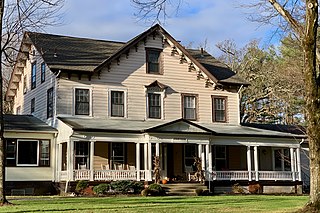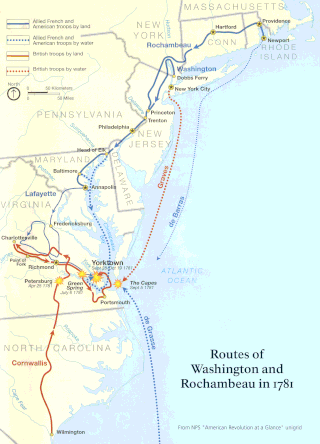
Quercus alba, the white oak, is one of the preeminent hardwoods of eastern and central North America. It is a long-lived oak, native to eastern and central North America and found from Minnesota, Ontario, Quebec, and southern Maine south as far as northern Florida and eastern Texas. Specimens have been documented to be over 450 years old.

Bernards Township is a township in Somerset County, in the U.S. state of New Jersey. As of the 2020 United States census, the township's population was 27,830, an increase of 1,178 (+4.4%) from the 2010 census count of 26,652, reflecting an increase of 2,077 (+8.5%) from the 24,575 counted in the 2000 census.

Basking Ridge is an unincorporated community and census-designated place (CDP) located within Bernards Township in the Somerset Hills region of Somerset County, in the U.S. state of New Jersey.

Johns Island is an island in Charleston County, South Carolina, United States, and is the largest island in the state of South Carolina. Johns Island is bordered by the Wadmalaw, Seabrook, Kiawah, Edisto, Folly, and James islands; the Stono and Kiawah rivers separate Johns Island from its border islands. It is the fourth-largest island on the US east coast, surpassed only by Long Island, Mount Desert Island and Martha's Vineyard. Johns Island is 84 square miles (220 km2) in area, with a population of 21,500.

Schooley's Mountain is an unincorporated community located within Washington Township in Morris County, in the U.S. state of New Jersey. Named for the Schooley family who owned a considerable amount of land there in the 1790s, the community is on Schooley's Mountain, a mountain with an elevation of about 1,000 feet (300 m) directly north of Long Valley. Located about 45 miles (72 km) from New York City, the community is situated 600 feet (180 m) above the surrounding valley. It contains many housing developments and Schooley's Mountain Park, a recreational area with an overlook, a waterfall, and numerous hiking paths, as well as Lake George. In its past, Schooley's Mountain was a resort and an estate.

The Somerset Hills is known as the northern region of Somerset County located in the U.S. state of New Jersey and includes the municipalities of Bedminster, Bernardsville, Bernards Township, Far Hills, and Peapack-Gladstone. The Morris County municipalities of the Chesters and the Mendhams are periodically recognized as part of the Somerset Hills.

The Washington–Rochambeau Revolutionary Route is a 680-mile (1,090 km) series of roads used in 1781 by the Continental Army under the command of George Washington and the Expédition Particulière under the command of Jean-Baptiste de Rochambeau during their 14-week march from Newport, Rhode Island, to Yorktown, Virginia.

The First Church of Hanover, also known as the First Presbyterian Church of Hanover or the Hanover Presbyterian Church, is located on Mount Pleasant Avenue in East Hanover, Morris County, New Jersey, United States. Established in 1718 in what was then the British Province of New Jersey, it is a member of the Presbyterian Church (USA) and is the oldest religious congregation in Morris County. The congregation's current building, constructed in 1835, is listed on the National Register of Historic Places.

Brick Academy is the nickname for a Federal-style brick building built in 1809 to meet the growing needs of the Basking Ridge Classical School located in the Basking Ridge section of Bernards Township, Somerset County, New Jersey. That school existed prior to 1799, at least 10 years before the construction of this building in 1809. The brick building was constructed for the elementary school run by local Presbyterian pastor, Rev. Robert Finley. This was about halfway through Rev. Finley's time at Basking Ridge. During the time he ran the school, attendance grew from fewer than 12 to an average near 25 students, and sometimes as high as 40 students. Students came from near & far, mostly from prominent families. The school was a high end preparatory school for boys who generally continued on to the College of New Jersey, later, known as Princeton University. In 1817, Rev. Finley quit Basking Ridge to briefly become president of the University of Georgia in Athens, GA. By 1828, the "Brick Academy" corporation was formed and the building continued use as a private, then public school in 1853, before being used for other purposes.

Morristown Green, most commonly referred to as the Green, is a historical park located in the center of Morristown, New Jersey, United States. It has an area of two and a half acres and has in the past served as a military base, a militia training ground, and an area for public executions. It is now a public park in which many community events are held. It was added to the National Register of Historic Places, listed as a contributing property of the Morristown District, on October 30, 1973.

Fairfield Presbyterian Church is a historic Presbyterian Church in America congregation in the Fairton section of Fairfield Township in Cumberland County, New Jersey. It was founded in 1680 when a log church was built on the banks of the Cohansey Creek, and it is the oldest existing congregation currently within the PCA. This log church was replaced by a New England style frame building sometime between 1713 and 1715.

The Old Scots Burying Ground is a historic cemetery located on Gordon's Corner Road in the Wickatunk section of Marlboro Township, in Monmouth County, New Jersey. It was added to the National Register of Historic Places on August 15, 2001, for its significance in history and religion. The Old Scots Burying Ground is about an acre in size, about 195 feet above sea level and dates back to 1685. The total number of burials at the cemetery is not precisely known, suggested by Symms, "There are a large number of graves in Old Scots yard without any inscribed stones". Some reports place the number as at least 100 known graves with most headstones of brown sandstone. However, more recent research using ground penetrating radar reported by the Old Tennent Church in 2001 has put the number of confirmed sites at about 122 graves with a possible 140 more unmarked; placing the number at about 262 total graves in the cemetery. In 1945, in an attempt to clean out the site of vegetation and over-growth, a bulldozer was used on the property and as a result some headstones were dislodged and broken stones removed. The defining structure in the cemetery is a tall monument to Rev. John Boyd, created by the J&R Lamb Company. Built to commemorate the first recorded Presbyterian ordination of Rev. John Boyd. The monument is currently owned by the Synod of the Northeast who holds the property deed but it is maintained by the Old Tennent Church. The last identified burial was in 1977.

The Arbutus Oak was a large white oak tree in Arbutus, Maryland, situated in the southwest corner of the I-695/I-95 interchange approximately four miles southwest of Baltimore. It split and half and fell in 2019, due to internal decay that caused its trunk to become unstable. At that time, it was thought to be 329 years old.

The Basking Ridge White Oak Tree was a white oak that stood in the churchyard of the Presbyterian Church in Basking Ridge, New Jersey. The tree was over 600 years old and died in 2016, before being cut down in 2017. It stood at 97 feet tall, and may have been the oldest white oak in the world.

Franklin Corners is an unincorporated community located along the Passaic River at the intersection of County Route 613 and U.S. Route 202 in Bernards Township of Somerset County, New Jersey. In the 19th century, it had a grist mill, saw mill, general store, school, and several houses. The Franklin Corners Historic District, featuring Van Dorn's Mill, was listed on the National Register of Historic Places in 1975.

The Henry Doremus House, also known as the Captain Thomas Doremus House, is a historic stone house located at 490 Main Road in the Towaco section of the township of Montville, New Jersey. The oldest section was built around 1760. It was added to the National Register of Historic Places on October 31, 1972 as the Doremus House for its significance in architecture. It was listed as the Henry Doremus House as part of the Dutch Stone Houses in Montville, New Jersey Multiple Property Submission (MPS) on January 17, 1992.





















